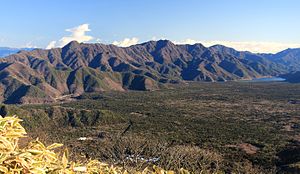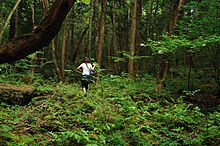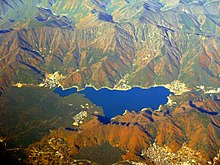AOKIGAHARA
Aokigahara (青木ヶ原), also known as the Sea of Trees (樹海 Jukai), is a forest on the northwestern flank of Japan's Mount Fuji thriving on 30 square kilometres (12 sq mi) of hardened lava laid down by the last major eruption of Mount Fuji in 864 CE.[1] The western edge of Aokigahara, where there are several caves that fill with ice in winter, is a popular destination for tourists and school trips. Parts of Aokigahara are very dense, and the porous lava absorbs sound, helping to provide visitors with a sense of solitude.[2]
The forest has a historical reputation as a home to yūrei: ghosts of the dead in Japanese mythology. In recent years, Aokigahara has become internationally known as one of the world's most prevalent suicide sites, and signs at the head of some trails urge suicidal visitors to think of their families and contact a suicide prevention association

The forest floor mostly consists of volcanic rock which can be difficult to penetrate with hand tools such as picks or shovels. Since the forest is very dense, in recent years, hikers and tourists trekking through Aokigahara have begun to use plastic tape to mark their paths so as to avoid getting lost.[3] Designated trails lead to several tourist attractions such as the Narusawa lce Cave and Fugaku Wind Cave which are two lava caves near to Mount Fuji, the ice cave being frozen all around the year.[4] The first kilometer of the forest is littered with tape and other rubbish left by tourists, despite officials' attempts to remove it. After the first kilometer into Aokigahara towards Mount Fuji within the Fuji-Hakone-Izu National Park, the forest is in better condition, with few obvious signs of human presence.[citation needed]
Aokigahara has been falsely portrayed as a place where navigational compasses go haywire. Needles of magnetic compasses will move if placed directly on the lava, aligning with the rock's natural magnetism, which varies in iron content and strength by location. However, a compass behaves as expected when held at a normal height.
Mammals include the Asian black bear,[5] small Japanese mole,[6] bats,[1] mice,[1] deer, fox, boar, wild rabbit, Japanese mink and squirrel.[7] Birds include great tit, willow tit, long-tailed tit, magerahigara, higera, great spotted woodpecker, pygmy woodpecker, bush warbler, Eurasian jay, Japanese white-eye, Japanese thrush, brown-headed thrush, Siberian thrush, Hodgson’s hawk-cuckoo, Japanese grosbeak, lesser cuckoo, black-faced bunting, oriental turtle dove, and common cuckoo.[7]
There are ground beetles and other insects,[1] including many species of butterflies, even in the forest interior Argynnis paphia, Chrysozephyrus smaragdinus, Celastrina argiolus, Celastrina sugitanii, Curetis acuta, Favonius jezoensis, Neptis sappho, Parantica sita and Polygonia c-album are found.[8]
The forest has a wide variety of conifers and broadleaf trees and shrubs including: Chamaecyparis obtusa,[8] Cryptomeria japonica,[9] Pinus densiflora, Pinus parviflora, Tsuga sieboldii, Acer distylum, Acer micranthum, Acer sieboldianum, Acer tschonoskii, Betula grossa, Chengiopanax sciadophylloides (as Acanthopanax sciadophylloides a.k.a. Eleutherococcus sciadophylloides), Clethra barbinervis, Enkianthus campanulatus, Euonymus macropterus, Ilex pedunculosa, Ilex macropoda, Pieris japonica, Prunus jamasakura, Quercus mongolica var. crispula, Rhododendron dilatatum, Skimmia japonica f. repens, Sorbus commixta (as Sorbus americana ssp. japonica) and Toxicodendron trichocarpum (as Rhus trichocarpa).[8] The dominant tree species between 1000 and 1800 metres of altitude is Tsuga diversifolia and from 1800 to 2200 metres is Abies veitchii.[9]

Deeper in the forest there are many herbaceous flowering plants including Artemisia princeps,[8] Cirsium nipponicum var. incomptum,[10] Corydalis incisa,[8] Erigeron annuus,[10] Geranium nepalense,[10] Kalimeris pinnatifida,[10] Maianthemum dilatatum,[8] Oplismenus undulatifolius[8] and Polygonum cuspidatum.[8] There are also the myco-heterotrophic Monotropastrum humile,[7] frequent liverworts,[9] many mosses[9] and many ferns.[7] The forest edges have many more species.

Aokigahara is sometimes referred to as the most popular site for suicide in Japan.[11] In 2003, 105 bodies were found in the forest, exceeding the previous record of 78 in 2002.[12] In 2010, the police recorded more than 200 people having attempted suicide in the forest, of whom 54 completed the act.[13] Suicides are said to increase during March, the end of the fiscal year in Japan.[11] As of 2011, the most common means of suicide in the forest were hanging or drug overdose.[13] In recent years, local officials have stopped publicizing the numbers in an attempt to decrease Aokigahara's association with suicide.[14]
The rate of suicide has led officials to place a sign at the forest's entry urging suicidal visitors to seek help and not take their own lives. Annual body searches have been conducted by police, volunteers, and attendant journalists since 1970.[15][16][17]
The site's popularity has been attributed to Seichō Matsumoto's 1961 novel Nami no Tō (Tower of Waves).[18][19] However, the history of suicide in Aokigahara predates the novel's publication, and the place has long been associated with death; ubasute may have been practiced there into the nineteenth century, and the forest is reputedly haunted by the yūrei of those left to die.[14]
Love Japan. Love mountains. Love hiking. Thanks for sharing. I'm Oatmeal. Happy Easter.
Nice Post dear. Welcome to steemit and enjoy your time here.
I have followed you, follow me back to be getting up votes from me on your future posts. https://steemit.com/@nwanne
Thank you.